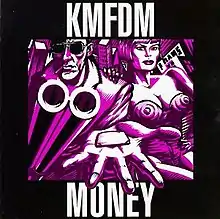KMFDM
KMFDM (originally Kein Mehrheit Für Die Mitleid, loosely translated by the band as "no pity for the majority")[1] is a multinational industrial band from Hamburg led by Sascha Konietzko, who founded the band in 1984 as a performance art project.
KMFDM | |
|---|---|
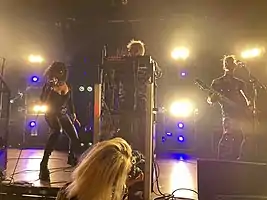 KMFDM live in 2022 | |
| Background information | |
| Origin | Hamburg, Germany |
| Genres | |
| Years active |
|
| Labels |
|
| Members |
|
| Past members | |
| Website | kmfdm |
 | |
The band's earliest incarnation included German drummer En Esch and British vocalist Raymond Watts, the latter of whom left and rejoined the group several times over its history. The trio recorded the band's earliest albums in Germany before Konietzko and Esch moved to the United States, where they found much greater success with seminal industrial record label Wax Trax!. German guitarist Günter Schulz joined in 1990; both he and Esch continued with the band until KMFDM broke up in 1999. Konietzko resurrected KMFDM in 2002 (Esch and Schulz declined to rejoin) on Metropolis Records, and by 2005 he had assembled a consistent line-up that included American singer Lucia Cifarelli, British guitarists Jules Hodgson and Steve White, and British drummer Andy Selway. Konietzko and Cifarelli moved back to Germany in 2007, while the rest of the band stayed in the U.S. Hodgson and White moved on to other pursuits between 2015 and 2017, leaving the band a working trio unofficially. In addition to these core members, dozens of other musicians have worked with the group across its twenty studio albums and two dozen singles, with sales totaling in excess of two million records worldwide.
Critics consider KMFDM one of the first bands to bring industrial music to mainstream audiences, though Konietzko refers to the band's music as "The Ultra-Heavy Beat". The band incorporates heavy metal guitar riffs, electronic music, samples, and both male and female vocals in its music, which encompasses a variety of styles including industrial rock and electronic body music. The band is fiercely political, with many of its lyrics taking stands against violence, war, and oppression. KMFDM normally tours at least once after every major release, and band members are known for their accessibility to and interaction with fans, both online and at concerts. Members, independently or working together and with other musicians, have recorded under many other names, primarily Watts' Pig, Konietzko's Excessive Force, and Esch and Schulz's Slick Idiot.
History
Origin (1984)
KMFDM was officially founded in Paris, France, on February 29, 1984, as a performance art project between Sascha Konietzko and German painter and multimedia artist Udo Sturm at the opening of an exhibition of young European artists at the Grand Palais.[2] The first show consisted of Sturm playing an ARP 2600 synthesizer, Konietzko playing bass guitars with their amplifiers spread throughout the building,[3] and four Polish coal miners (whom Konietzko had met at a bordello)[4] pounding on the foundations of the Grand Palais.[1]
Name

KMFDM is an initialism for the nonsensical and grammatically incorrect German phrase Kein Mehrheit Für Die Mitleid, which, keeping the same word order, literally translates as "no majority for the pity", but is typically given the loose translation of "no pity for the majority".[2][5][6][7] In the original phrase, the articles preceding the nouns Mehrheit and Mitleid are inflected for the wrong gender, as the proper declension would be Keine Mehrheit für das Mitleid. Swapping the two nouns yields the grammatically correct Kein Mitleid für die Mehrheit, which translates directly as "no pity for the majority". In a 2003 interview, Konietzko explained the origins of the phrase:
"On the morning of February 29th, 1984 I woke up and went down to breakfast at a hotel in Paris. We had a show that night opening for an exhibition for young European artists. ... we needed a motto for the night so that we could make up some fliers and post them around. There was a German newspaper on the table and so I started cutting out words and threw them all into a cap. We picked a few of them out and it read "Kein Mehrheit Für Die Mitleid". It's kinda improper German in regards to its translation but in the DA-DA-esque [sic] mindset of the early morning it made perfect sense. So when I was on my way back to Hamburg I'd mentioned it to Raymond [Watts]. He liked it but he was having difficulty pronouncing it correctly. So finally he said, 'Why don't you just call it KMFDM?' So that was it. We were KMFDM."[8]
The initialism has jokingly been said to stand for "Kill Mother-Fucking Depeche Mode", coined by the band on their first U.S. tour and used as recently as Kunst.[9]
Early years in Germany (1984–89)
Sturm left early on,[10] but Konietzko continued performing, at one point having twenty people in his troupe, which by then was engaged in antics such as fire eating and throwing entrails at audiences.[4] Konietzko then returned to Hamburg, where he joined up with Peter Missing in his new band Missing Foundation.[10] Drummer Nicklaus Schandelmaier,[11] who had recently moved to Hamburg from Frankfurt, joined the group, and took the stage name En Esch. Although the group did some live performances,[10] Konietzko and Esch dropped out of Missing Foundation before any recordings were made and went back to work as KMFDM,[2] collaborating with Hamburg-based studio owner Raymond Watts.[1]
Cassette copies of the band's first album, Opium, began circulating through the underground clubs and bars of Hamburg in 1984.[1] KMFDM released its next album, What Do You Know, Deutschland?, in December 1986.[1] It was recorded from 1983 to 1986, with some of the songs recorded by Konietzko and Watts before Esch was a member of the band,[2] and indeed, before the band officially existed. Skysaw Records gave the album a second UK release in 1987 and introduced the band to visual artist Aidan Hughes, usually credited as Brute!. Hughes redesigned the album's cover,[1] and went on to design almost every KMFDM album cover.[2]
Watts left the group after working on just three songs on 1988's Don't Blow Your Top[12] to start his own project, Pig.[13] After working the Hamburg underground music scene and releasing albums on European labels, the band began its long-standing relationship with Wax Trax! Records when Don't Blow Your Top was licensed to the label for US distribution.[1] The album was produced by Adrian Sherwood, and was described by AllMusic critic Dave Thompson as "[highlighting] the producer as much as the band".[14]
Success in the US (1990–94)
KMFDM recorded and released its fourth album, UAIOE, in early 1989 for distribution in both the U.S. and Europe,[1] arrived in America for the first time on December 16,[16] and commenced touring the U.S. with Ministry.[10] During KMFDM's first US tour, band members started using the phrase "Kill Motherfucking Depeche Mode" for the initialism to tease journalists who did not understand German.[9] The band signed directly to Wax Trax! to distribute its fifth album, Naïve,[1] which was recorded in Europe and featured the debut of guitarist Günter Schulz, known at the time as Svetlana Ambrosius. A remix of the album's title track was the group's first hit, reaching No. 21 on Billboard's Dance/Club Play Songs Chart in March 1991.[17]
Konietzko moved to Chicago in 1991,[2][18] and Esch followed a year later. KMFDM quickly became a part of the Chicago industrial music scene that included Ministry, My Life with the Thrill Kill Kult, and Revolting Cocks.[19] Konietzko later remarked, "We came from Germany and we all had to have day jobs and work our asses off to afford to be KMFDM and all of a sudden we're in the states and we're selling thousands of thousands of [sic] fucking records!"[9]
The band's next club hit was "Split", which was released in June 1991 and reached No. 46 on Billboard's Dance/Club Play Songs Chart in July.[17] During 1991, Konietzko collaborated with Buzz McCoy of My Life With the Thrill Kill Kult to record an album under the name Excessive Force titled Conquer Your World.[20] Konietzko and Esch then began work on their halves of the intended sixth album, Apart, which was eventually released as two separate albums.[21] Esch's half became his solo album, Cheesy, while the official KMFDM album used Konietzko's material and was renamed Money.[21] This album spawned two more club hits in 1992: "Vogue", which reached No. 19 on the Billboard Dance/Club Play Songs Chart in April, and the title track, which reached No. 36 on that same chart in July.[17]
After touring in 1992 with drummer Chris Vrenna,[22] the then-core of KMFDM (Konietzko, Esch, Schulz, and second guitarist Mark Durante) returned to Chicago and found that Wax Trax! had filed Chapter 11 bankruptcy to begin corporate reorganization in November 1992.[1][23] The band went into the studio in 1993 as a group to record its seventh album, Angst, which sold more than 100,000 copies over the next two years.[11] Esch said after the album's release, "I like this album way more. Money was done in a hurry, and I was doing a major Pigface tour, so I didn't have much influence on the album. I really like Angst. I'm totally down with it. We've tried to involve guitar players, we tried to be like a real band, especially in the creative kind of aspect."[24] After the release of Angst, Wax Trax!/TVT Records launched a promotion in which fans were encouraged to devise as many alternate meanings for KMFDM as possible, with more than a thousand submissions resulting.[2]
Konietzko released a second album under the Excessive Force moniker in 1993 titled Gentle Death.[20] KMFDM received its first exposure to the mainstream with its single "A Drug Against War". Despite the band's anti-MTV stance,[9] the video of "A Drug Against War" received airplay on MTV[2] and was shown on the MTV cartoon Beavis and Butt-head.[25] The track "Light" reached No. 31 on the Billboard Dance/Club Play Songs Chart in May 1994.[17]
The song "Liebeslied" from Naïve originally contained an unlicensed sample of "O Fortuna" from Carl Orff's Carmina Burana.[26] Orff's publisher threatened the band with legal action,[27] and the album was withdrawn from production in 1993. A new version of the album, titled Naïve/Hell to Go, was released the following year.[1] It contained new mixes of several songs, including a version of "Liebeslied" with the offending sample removed.[28]
Wax Trax! was saved from bankruptcy by an infusion of funds from TVT Records,[1][2] and in March 1994 announced plans to release the compilation set Black Box – Wax Trax! Records: The First 13 Years,[23] which includes the KMFDM songs "Virus" and "Godlike",[29] two songs which Thompson called "defining".[14]
Peak popularity (1994–99)
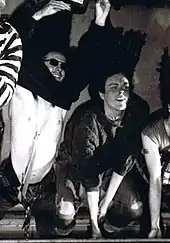
The mid-to-late 1990s were KMFDM's most successful years in terms of album sales and mainstream awareness. Konietzko moved to Seattle in 1994, while Esch moved to New Orleans.[26] Watts rejoined the band to work on its eighth album, Nihil, which peaked at No. 16 on the Billboard Heatseekers chart[30] and sold 209,000 copies, making it the band's best-selling album.[31] It marked the first contributions by drummer Bill Rieflin, who worked with the band on its next five albums. Nihil featured KMFDM's most widely known song, "Juke Joint Jezebel", versions of which appeared on both the Bad Boys and Mortal Kombat soundtracks, the latter of which peaked at No. 10 on the Billboard 200[32] and sold over 1.8 million copies.[33] Their song "Ultra" was used in the English version of Street Fighter II: The Animated Movie.
Commenting on the rotating cast of musicians shortly after Nihil's release, Konietzko said, "It's as if En and I are the suns and the other musicians at the time come and revolve around us."[5] Regarding the duo's dynamic, Konietzko said, "En Esch and myself have always been the cornerstone of KMFDM's existence. And we are diametrically opposed as writers. The angsty stuff generally comes from him. The poppy, hard stuff comes from me."[34] Esch commented in 1994, "Sascha and myself are different, of course. But that's why we can still make things happen. Our best and worst qualities are contrary. To put it simply, he's more organized and stable, I'm more complicated and abstract."[24]
In late 1995, close friend and president of Chicago's Wax Trax! Jim Nash died of an illness complicated by AIDS,[19] and Seattle became the official headquarters of KMFDM.[1][2] Watts toured with KMFDM throughout 1995 in support of Nihil, but then left the group to return to recording under the Pig moniker. Esch separated from the group, and Xtort was created in 1996 almost entirely without his input.[40] Konietzko instead brought in a number of other industrial artists such as Chris Connelly to assist with the album.[40] Xtort was the first KMFDM album to chart on the Billboard 200 and the highest-charting album in the band's history, reaching No. 92[41] and selling more than 200,000 copies.[42] "Power", the album's first single, was the most heavily promoted song in the band's history, with almost 100,000 copies included in a free Wax Trax! sampler album in mid-1996.[43] Konietzko later said Xtort was his favorite album of the 1990s.[44]
Esch returned for the Symbols album, which was released in 1997 and featured Abby Travis and Skinny Puppy's Nivek Ogre.[45] Symbols reached No. 137 on the Billboard 200.[41] Its first track, "Megalomaniac", was featured in the film Mortal Kombat Annihilation, and was the first song from its soundtrack to receive radio airplay.[46] Tim Skold, formerly of the band Shotgun Messiah, made his first appearance as a band member, writing lyrics and performing vocals on "Anarchy".[47][48] Looking back on Symbols in 2002, Konietzko said, "I listened to the Symbols album and heard exactly why KMFDM broke up in the first place. It told me the story of what went wrong. There were maybe two (good) songs on that album and the others were just a bunch of compromising tug-of-wars. That was something I was not going to do again."[49]
The band released a pair of compilation albums in 1998. The first, Retro, was a greatest hits compilation which included most of the singles released up until Xtort.[50] The second, Agogo, was a collection of rarities and previously unreleased tracks, including a cover of U2's "Mysterious Ways".
Adios (1999) and the Columbine High School massacre
The album Adios was written and performed almost exclusively by Konietzko and Skold.[51] Ogre again provided vocals, as did German musician Nina Hagen.[51] Originally the fulfillment of the band's ten record contract with Wax Trax!/TVT,[52] Adios later signaled the breakup of the band itself,[51] which Esch's and Schulz's limited participation foreshadowed.[51]
KMFDM disbanded, albeit temporarily, on January 22, 1999, with only Konietzko and Skold remaining together.[48] Konietzko said the split was due to "lots of stress and pressure, as well as differences in vision and drive".[48] Esch said "There was a lot of negative energy between Sascha and Günter Schulz and myself and we all decided on the phone to call the band quits."[53] Adios was released three months later, and reached No. 189 on the Billboard 200.[41] Its title track was called "a bitter goodbye".[54]
In the wake of the Columbine High School massacre, it was revealed that lyrics to KMFDM songs ("Son of a Gun", "Stray Bullet", "Waste") were posted on the website of shooter Eric Harris,[55] and that the date of the massacre, April 20, coincided with both the release date of the album Adios[56] and the birthday of Adolf Hitler.[57] Some journalists were quick to jump on the possibility that the actions of Harris and the other shooter, Dylan Klebold, were inspired by the violent entertainment and Nazism,[58] though one wrote, "Lyrically, the band has written some songs that could easily be misconstrued by anyone lacking an ear for irony and looking for an excuse to commit violence."[59] In response, Konietzko issued a statement:
MDFMK, Slick Idiot, and reformation (2000–02)
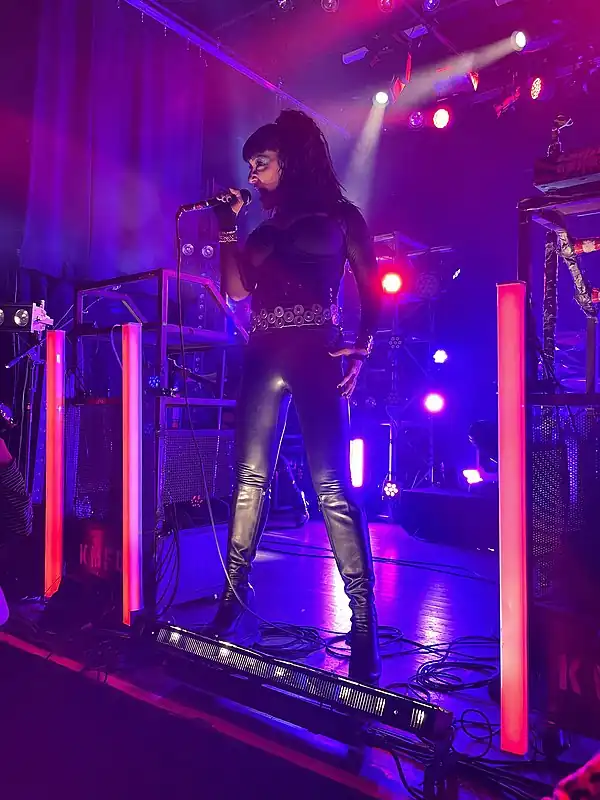
After the group disbanded, Schulz and Esch formed the band Slick Idiot,[62] while Konietzko and Skold regrouped as MDFMK, adding singer Lucia Cifarelli to form a trio.[63] MDFMK released one self-titled album with Republic/Universal Records, and toured North America.[64] After being released from his contract with Universal due to a disagreement over who would produce the next album, Konietzko said he called Metropolis Records and asked if they'd be interested in signing KMFDM. The label agreed, although at the time only Konietzko himself was certain to participate.[8]
Konietzko announced the return of KMFDM in early 2001, due to "public demand", with Skold, Cifarelli, and former collaborators Watts and Rieflin joining him in the studio;[48] he said at the time, "I talked with the usual KMFDM suspects to see if they were interested, and what we came up with was something better than what we had before."[49] Recalled Esch in 2009, "I was happy about my new creative freedom at that time and so I refused the concept of a fast reunion of the original KMFDM."[53] Konietzko said of the reformed band, "Not only is it fun again, but it's devoid of all the personal confrontations due to egos and fractions that were once a part of the band,"[49] but said, "I really miss En Esch," in 2003.[8] KMFDM released its first album in three years, Attak, in March 2002. The album was on the Billboard Independent Albums Chart for four weeks, peaking at No. 11.[65]
New line-up (2003–07)
Skold left after Attak to join Marilyn Manson.[66] Over the next few years, Watts' bandmates from Pig joined KMFDM one by one. Jules Hodgson had already done guitar work for 2002's Attak.[67] Andy Selway first played drums for KMFDM on WWIII in 2003,[68] and Steve White contributed to 2005's Hau Ruck after touring with the band.[69] All three, along with Watts and Cifarelli, were mentioned as band members on "Intro", the final track on WWIII,[70] although that was to be the last album on which Watts performed. WWIII was on Billboard's Dance/Electronic Albums Chart for seven weeks, and peaked at No. 3.[71]
Opium was re-released in 2002 as KMFDM001 on the band's new label, KMFDM Records,[72] and a collection of songs recorded between 1984 and 1986 was released in 2004.[73] Shortly after the release of WWIII, Konietzko began work on the soundtrack for 2004's Spider-Man 2 video game.[74] Hau Ruck performed about as well as WWIII, appearing on Billboard's Dance/Electronic Albums Chart for eight weeks but only hitting No. 5.[71] Unlike WWIII, Hau Ruck showed up on the Billboard Independent Albums chart for a single week at No. 48.[65] A companion EP, Ruck Zuck, was released in 2006.
Konietzko took a new approach for Tohuvabohu, released in 2007. "Principally in the past, there used to be 2 people that would start songs: me and Jules. On this record I said to the other 2 guys, Andy (Selway) and Steve (White), 'Why don't you guys come up with something?'"[75] Tohuvabohu was on Billboard's Dance/Electronic Albums Chart for just three weeks and peaked at No. 4.[71] It appeared on the Independent Albums Chart for one week at No. 29.[65] Tohuvabohu had a companion, Brimborium, a full length remix album released in 2008 that barely made it onto Billboard's Dance/Electronic Albums Chart, hitting No. 20 for a single week.[71]
Metropolis Records announced in mid-2006 it would reissue KMFDM's entire Wax Trax!-era studio album back catalog, which had been out of print since the early 2000s. The albums were released in chronological order in groups of two or three from September 2006 to May 2007.[76] Konietzko said the remastering was done over concerns about losing the rights to the back catalog after TVT defaulted on a loan, explaining, "The original agreement was that the catalog would have reverted back to me in 2008, anyway, but TVT and Rykodisc were thinking of just making a KMFDM compilation, which would have eliminated my catalog, and I didn't want that."[77] Konietzko commented in 2006 that the current line-up was the best he had worked with,[77] and said in a separate interview that his former bandmates were "looking at me for handouts".[78] Konietzko announced in October 2007 that he was packing up and moving back to Germany in the next three months.[9]
Return to Germany (2007–2016)

Following the Finnish school shootings of 2007 and 2008, media reports again attempted to draw a connection between the shooters and KMFDM, and noted that both listed the band among their favorites.[79][80] In an interview with Norwegian broadcaster NRK shortly after the 2008 incident, Konietzko responded to these claims by saying the recent shootings were a by-product of the copycat mentality and the Finnish shooters' desire to emulate the lifestyles and actions of the Columbine shooters. "One of my biggest concerns immediately following this incident [the Columbine shooting] was that there would be copycats repeating such things in the future, as there often are when people commit heinous crimes and acts of violence. I was, unfortunately, right."[81]
KMFDM re-released all of its old singles and hard-to-find tracks from before the 1999 breakup in a series of three double albums called Extra—Vol. 1, Vol. 2, and Vol. 3—in mid-2008. KMFDM Records released Skold vs. KMFDM in early 2009, which was a collaboration that Skold and Konietzko conducted over the Internet while on separate continents from June to October 2008.[82] A follow-up is planned, but is not a high priority.[83]
KMFDM's sixteenth studio album, Blitz, released in March 2009, showcased further collaboration with Skold, but less input from the band members not living in Germany. It reached No. 4 on Billboard's Dance/Electronic Albums Chart, and was on the chart for four weeks.[71] Its companion remix album, Krieg, was released in early 2010.[84] Two compilation albums, Würst and Greatest Shit, were released in September that same year.[85]
On December 14, 2010, the official KMFDM website was changed to include a single image with the text "All Systems Have Been Ripped. The Internet Has Been Shut Down."[86] A new song titled "Rebels in Control" became available for listening and download on the site, posted in support of Julian Assange with regards to the controversy over WikiLeaks.[87][88]
Former band members Durante, Esch, Schulz, and Watts appeared with Mona Mur at the April 2011 Wax Trax! Retrospectacle in Chicago,[89] a charity event celebrating the industrial music label.[90] The group performed KMFDM songs from the Wax Trax! era, including "Juke Joint Jezebel", "Godlike, "Brute", and "Don't Blow Your Top".[91] Konietzko expressed a desire to perform with the current band line-up, but was turned down by event organizers.[92]
KMFDM released WTF?! in April 2011, featuring what Konietzko called "a slew of guest musicians"[95] including Rieflin, Koichi Fukuda, Free Dominguez, and William Wilson.[83][96] The album's first single, "Krank", charted in both Germany and the United States.[97] WTF?! was on Billboard's Dance/Electronic Albums Chart for one week at No. 8.[71]
Work on KMFDM's eighteenth album began in February 2012.[98] Titled Kunst, it was released on February 26, 2013.[99] The band toured the United States in March and Europe in April 2013.[100] KMFDM reissued Opium and WWIII in October 2013.[101]
On May 24, 2014, Konietzko announced on the band's Facebook page that a new album, titled Our Time Will Come, would be released on October 14, 2014. A new live album titled We Are KMFDM and a single called "Genau (The German in You)" were also announced.[102] Our Time Will Come was released on October 14, 2014, on both CD and vinyl.[103] The "Genau" single was not released, with a single for "Salvation" from the same album coming out instead in 2015.
Another line-up shift (2017–present)

In April 2017, KMFDM revealed a new EP titled Yeah!; an album called Hell Yeah was released in August, with a U.S. tour planned in support of the releases for October.[104] On June 23, Yeah! was released, followed by the release of Hell Yeah on August 18. Guitarists White and Hodgson were unavailable, so Konietzko recruited Chris Harms from Lord of the Lost to record the guitar parts. Harms, along with Lord of the Lost bandmates Pi (guitar) and Gared Dirge (keyboards), had been slated to perform as the live band for KMFDM's late 2017 tour. Lord of the Lost were unable to secure work visas to enter the U.S.,[105] so Andee Blacksugar was tapped to handle guitar tasks instead.[106] The new quartet of Konietzko, Cifarelli, Selway, and Blacksugar announced the album, Paradise, for release on September 27, 2019. The band features a variety of guest appearances, including KMFDM co-founder Raymond Watts for the first time since 2003.[107] In July 2022, the band announced a brand new album, Hyëna was released on September 9. The title track was revealed as a promotional single at the end of August.[108]
Musical style, influences, and lyrical content
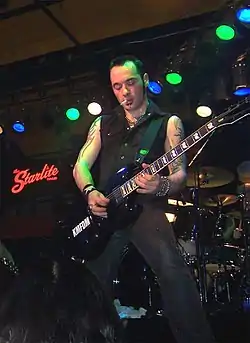
KMFDM's earliest output was performance art,[88] as Konietzko incorporated not only visuals such as burning beds and exploding televisions,[11] but also non-musical devices used as instruments, e.g. vacuum cleaners.[11][109] The 1980s albums featured heavy use of sampling and studio manipulations, and the primary instruments used were synthesizers and drum machines. Konietzko has cited T. Rex, David Bowie, and Frank Zappa as inspiration in the early stages of KMFDM.[16][42] Before forming the band, he listened to punk music like GBH and "true industrial" bands such as Throbbing Gristle.[34]
The band's music has been described as industrial,[110] industrial rock,[7] electro-industrial,[111] industrial metal,[112] and techno-industrial.[113] While recognized along with Ministry, Nine Inch Nails, and Skinny Puppy as pioneers in introducing industrial music to mainstream audiences,[14] KMFDM describes its sound as "The Ultra-Heavy Beat".[109] Konietzko once stated, "If I was to give myself a label it would be industrial-alternative-electronic-crossover-rock and danceabilly."[14]
The band has made heavy use of guitars since its inception,[14] and pioneered their use during the band's early days in Germany.[34] Although not a metal fan, Konietzko said his "infatuation with ripping off metal licks" stemmed from his experiments with E-mu's Emax sampler in late 1986, adding, "What I always hated most about heavy metal was that the best riffs came only once and were never repeated. So the fascination, actually, was to sample a great riff, loop it, and play it over and over again."[112] While the album Don't Blow Your Top was more sparse in content, due to the influence of producer Sherwood,[14][114] it was the exception rather than the rule. Ministry founder and frontman Al Jourgensen, on tour with the band in 1989, described KMFDM as "a battalion of guitars marching through Europe."[14]
KMFDM's music has since been a fusion of electronic and heavy metal,[14][114] with occasional elements of dub,[114][116] as well as orchestral samples[117] and live horns.[38] Many songs feature prominent backing vocals by female singers[37] such as Dorona Alberti,[118] Travis, and Cifarelli. Many of the musicians who have played in the band are multi-instrumentalists, so there is a degree of versatility and freedom in the music.[9]
Many albums feature one or more songs in which the band lampoons itself, notably in the lyrics to "Sucks"[118] and "Inane".[40] The band's "cynical detachment" has been compared to Steely Dan.[119] Lyrics often express political concerns[37][118] and call for the rejection of and resistance to terrorism, violence, oppression, censorship, and war.[120][121] In the 1995 song "Terror", Konietzko specifically warns, "Fundamentalist forces are undermining the integrity of liberal and democratic political structures".[120] Samples of news broadcasts and speeches by political leaders are sometimes featured in songs.[114] Konietzko has said that while the 2003 album WWIII is critical of then-president George W. Bush, who was sampled extensively for the album,[122] "It's not an anti-Bush record per se, it's an anti-stupidity record", and, "If we had a message, it would be: Think for Yourself and Don't Believe the Bullshit."[123]
Reception
As of July 2007, KMFDM had sold approximately two million records worldwide.[124] Critics have been widely positive of KMFDM, though less enthusiastic about the band's earliest work. What Do You Know, Deutschland? was called "less energetic" and Don't Blow Your Top was called "a little flimsy" in comparison to later albums by AllMusic critics Andy Hinds and Vincent Jeffries, respectively.[12][115] UAIOE, when the band's sound began to develop, was called "more assured" by Hinds and "more representative of KMFDM's true motives" by Thompson, who added that KMFDM's guitar-heavy sound inspired Ministry's own embrace of the instrument after the bands toured together in 1990.[14][15]

The first major breakthrough in the band's critical reception was 1990's Naïve, called "one of their strongest releases" by Stephen Thomas Erlewine of AllMusic,[125] "brilliant" by fellow AllMusic critic Ned Raggett,[126] "superb" by Hinds,[127] and "the most fun 'industrial dance' album ever" by Spin critic Chuck Eddy.[128] The subsequent albums released in the 1990s were described as some of the band's strongest by AllMusic critic Greg Prato,[2] with their metal guitars, industrial beats, and dance floor sensibilities praised by Ira Robbins and CMJ New Music Monthly critic Heidi MacDonald.[114][119] Michael Saunders of the Boston Globe said of the band: "It's a small field, but KMFDM is tops in it: makers of dense, danceable, post-industrial torrents of noise. The German band specializes in fabricating aural assaults that can be intimidating to the uninitiated."[129] MacDonald said in 1996, "With Ministry gone grindcore, Skinny Puppy just gone, and Nine Inch Nails a brand name, KMFDM is now the standard bearer of industrial",[40] though Erlewine and Hinds felt the band was losing some steam towards the end of the decade.[130][131]
Greg Rule declared in 1999, after its temporary disbandment, that KMFDM had "produced nine high-impact records that have earned them a large, loyal fanbase strewn across the planet."[132] Erlewine called the band "one of Wax Trax's first industrial superstars", "an underground sensation", and "one of the major industrial bands of the '90s."[110] Most of the band's albums released in the 21st century have been well-received, although Prato has commented on the sameness from one album to the next.[2][133] Recent albums Blitz and WTF?! have been described as moving in an electronic, less guitar-focused direction by Trey Spencer of Sputnikmusic and AllMusic's David Jeffries.[134][135]
Touring and fanbase
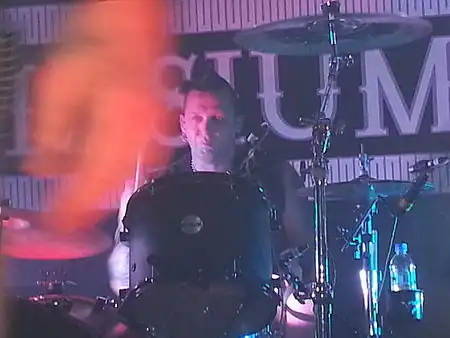
KMFDM has released on average an album every year and a half, and usually tours at least once in support of each album. At most concert venues, KMFDM mingles with the fans before and after the show to sign autographs, pose for photos, and answer questions.[9] Konietzko, who keeps in contact with fans via e-mail and the band's website,[43] and band representatives have experimented with ways for fans to interact more directly. KMFDM launched "Horde" in 2002, an exclusive fan club which gave members the opportunity to attend a private meet-and-greet with the band before every show, and allowed access to members-only music and footage online. A featurette on the Horde fan club appears on the WWIII Live 2003 DVD.[136]
In the 2004 Fankam project, an audience member was selected at each concert to record that night's show, as well as some back-stage antics, with a hand-held digital video camera. The resulting footage was incorporated into the following year's 20th Anniversary World Tour DVD, which included fan photos submitted to the KMFDM official website. KMFDM encouraged fans to call a special "FanPhone" and leave a voice message in March 2007.[75] The song "Superpower" from 2007's Tohuvabohu includes sound-clips from these messages.[137] The band used the Fankam project again for its 2011 "Kein Mitleid" tour in the United States.[138]
List of tours
All tours featured KMFDM headlining, except where noted.
| Date | Name | Location | Notes | Source |
|---|---|---|---|---|
| 1989–90 | "The Mind Is a Terrible Thing to Taste" | United States | opening for Ministry | [1] |
| 1990 | "Naïve" | Europe | with My Life with the Thrill Kill Kult | [1] |
| 1991 | "Split" | United States | [1] | |
| June 1992 | "Aloha Jerry Brown" | United States | [1][21][139] | |
| October–November 1992 | "KMFDM Sucks Money" | United States | [1][140][141] | |
| 1994 | "Angstfest" | United States | Support: Sister Machine Gun and Chemlab | [1] |
| May 1995 | "Beat by Beat" | United States | Support: Dink | [1][142][143] |
| Fall 1995 | "In Your Face" | United States and Europe | Support: God Lives Underwater and Genitorturers | [1] |
| 1997 | "Symbols" | United States and Europe | [67] | |
| 2002 | "Sturm & Drang" | United States | Sturm & Drang Tour 2002 live album, 16volt opened | |
| 2003 | "WWIII" | United States | WWIII Live 2003 live album | |
| 2004 | "20th Anniversary" | United States, Canada, Europe, Russia, and Australia | [144] | |
| 2005 | "Hau Ruck" | [85] | ||
| 2006 | "Hau Ruck Zuck USSA" | [85] | ||
| 2009 | "Kein Mitleid" | United States, Canada, and Europe | [85] | |
| 2010 | "Für die Mehrheit" | Europe | [85] | |
| August 2011 | North American tour | United States and Canada | [145] | |
| Fall 2011 | European tour | Europe | [145] | |
| Summer 2012 | European tour | Germany, Belgium, and France | [146] | |
| March 2013 | "USSA 2013" | United States | [100] | |
| April 2013 | "Europe 2013" | Europe | [100] | |
| Fall 2013 | "We Are KMFDM 2013" | United States & Canada | Support: Chant | [147] |
| Summer 2015 | "Salvation Tour 2015" | United States & Canada | Support: Chant | [148] |
| Fall 2017 | "Hell Yeah Tour 2017" | United Kingdom & United States | Support: Lords of the Lost & Inertia, DJ Ritual & ohGr (select dates) | [149] |
| September-October 2022 | "US Tour 2022" | United States | Support: Chant | [150] |
Album artwork
KMFDM has a long-standing relationship with commercial artist Aidan "Brute!" Hughes, who creates the artwork adorning almost all of the band's albums and singles,[2] which has been called "one of rock music's most memorable cover art collections".[115] Hughes' artwork is featured in KMFDM's music videos for "A Drug Against War" and "Son of a Gun", and on the band's promotional t-shirts.[152] Art critic Brian Sherwin said Hughes is probably best known for the collection of KMFDM artwork he has created.[153]
All of his work, which has been called "striking",[154] shares a distinct visual style inspired by Golden Age comic artists, Russian Constructivists, Italian Futurists, and woodcut artists.[155] In an interview with Sherwin, Hughes stated, "KMFDM have cornered the market in industrial post-modern angst and so my work reflects that."[153] Hughes said that initially he based his work on the music, which caused "artistic block".[151] Konietzko gave him more freedom to use whatever themes he wished, resulting in the cover to Money, which Hughes said "was based upon my disillusionment with the street lifestyle I was experiencing at the time, and the art carries with it the implication that no matter what temptation lies in your path, you still gotta pay!"[151]
The only studio album covers not designed by Hughes are Opium, which consists of a black-and-white photo, and Nihil, which was designed by Francesca Sundsten, wife of drummer Rieflin.[156]
Members
Current line-up
- Sascha Konietzko – vocals, guitars, bass, programming, keyboards, synthesizer, percussion, drums (1984–present)
- Lucia Cifarelli – vocals, keyboards (2002–present)
- Andy Selway – drums (touring 2002–2003, 2003–present)
- Andee Blacksugar – guitars, backing vocals (2017–present)
Key former members
- Raymond Watts – vocals, programming (1984–1988, 1994–1995, 1997, 2002–2004, guest 2019)
- En Esch – vocals, drums, guitars, programming (1985–1999)
- Rudolph Naomi – drums (1985–1986, 1988–1991)
- Günter Schulz – guitars, programming (1989–1999)
- Mark Durante – guitars (touring 1989, guest 1990, 1992–1997)
- Bill Rieflin – drums, programming, percussion, bass (guest 1990, 1995–1999, 2002–2003, guest 2011; died 2020)
- Tim Sköld – vocals, guitars, bass, drums, programming (1997–1999, 2002, 2009)
- Jules Hodgson – guitars, bass, keyboards (2002–2016, guest 2022)
- Steve White – guitars (touring 2002–2003, 2003–2015)
Discography
Studio albums
- Opium (1984)
- What Do You Know, Deutschland? (1986)
- Don't Blow Your Top (1988)
- UAIOE (1989)
- Naïve (1990)
- Money (1992)
- Angst (1993)
- Nihil (1995)
- Xtort (1996)
- Symbols (1997)
- Adios (1999)
- Attak (2002)
- WWIII (2003)
- Hau Ruck (2005)
- Tohuvabohu (2007)
- Blitz (2009)
- WTF?! (2011)
- Kunst (2013)
- Our Time Will Come (2014)
- Hell Yeah (2017)
- Paradise (2019)
- Hyëna (2022)
References
- "KMFDM History". KMFDM Inc. Archived from the original on April 8, 1997. Retrieved April 25, 2010.
- Prato, Greg. "KMFDM Biography". AllMusic. Rovi Corporation. Retrieved July 21, 2012.
- What Do You Know, Deutschland? (CD booklet). KMFDM. Philadelphia, Pennsylvania: Metropolis Records. 2006. p. 2. MET439.
{{cite AV media notes}}: CS1 maint: others in cite AV media (notes) (link) - Wiederhorn, Jon (August 8, 1996). "KMFDM make industrial music the old-fashioned way. They trash their hardware". Rolling Stone. No. 740. p. 24. Retrieved March 22, 2010.
- Iwasaki, Scott (May 5, 1995). "No Political Rage, Just 'Life, Normal Stuff' for KMFDM". Deseret News. p. 1. Retrieved July 11, 2012.
- Kennedy, Helen (April 21, 1999). "Outcast Clique Proud of Role". New York Daily News. Mortimer Zuckerman. Retrieved October 27, 2012.
- Mitchel, Wendy, ed. (February 8, 1999). "Top Stories: KMFDM Calls It Quits". CMJ New Music Report. Vol. 57, no. 604. p. 4. Retrieved July 22, 2012.
- Curry, Chris (November 1, 2003). "MK Magazine Interviews: KMFDM". MK Magazine. Archived from the original on August 26, 2007.
- Freedland, Israel; Schneider, Justin. "KMFDM Reloads with: Attak". Hybrid Magazine. Archived from the original on August 10, 2002. Retrieved May 9, 2012.
- Huey, Steve. "Missing Foundation Biography". AllMusic. Rovi Corporation. Retrieved July 22, 2012.
- Cardenas, Georgina (October 26, 1995). "KMFDM Blows Your Top". Miami New Times. p. 2. Archived from the original on January 7, 2014. Retrieved March 1, 2010.
- Hinds, Andy. "Don't Blow Your Top Review". AllMusic. Rovi Corporation. Retrieved July 21, 2012.
- "Raymond Watts Interview". Convulsion Magazine. 1992. Archived from the original on February 27, 2012.
- Thompson, Dave (2000). "The Industrial Gothic Complex". Alternative Rock. Hal Leonard Corporation. pp. 70–71. ISBN 978-0-87930-607-6. Retrieved September 9, 2010.
- Hinds, Andy. "UAIOE Review". AllMusic. Rovi Corporation. Retrieved July 19, 2012.
- "A Completely Different Chicken: KMFDM's Sascha K." Tastes Like Chicken. November 10, 2007. Retrieved March 6, 2010.
- "KMFDM Dance/Club Play Songs". Billboard. Retrieved March 6, 2010.
- McCarthy, Jackie (April 4, 1999). "Guns n Records". Seattle Weekly. Retrieved January 13, 2017.
- Rosenblum, Trudi Miller (October 21, 1995). "Jim Nash Dies at 47; Founder of Wax Trax!". Billboard. p. 10. Retrieved February 9, 2011.
- "Excessive Force Overview". AllMusic. Rovi Corporation. Retrieved April 7, 2010.
- Money (CD booklet). KMFDM. Philadelphia, Pennsylvania: Metropolis Records. 2006. pp. 2–3. MET463.
{{cite AV media notes}}: CS1 maint: others in cite AV media (notes) (link) - "Band News". KMFDM/Excessive Force Newsletter. No. 1. 1991. p. 3.
- Kot, Greg (March 11, 1994). "The Morrissey The Merrier". Chicago Tribune. p. 2. Retrieved May 10, 2012.
- Sutton, Jeneveve (January 1994). "Laff Mich Glucklich Seim". Magnet. Archived from the original on December 26, 2010. Retrieved July 19, 2012.
- "Mr. Anderson's Balls Episode". CBS. Archived from the original on September 16, 2011. Retrieved February 28, 2010.
- "KMFDM History on December 10, 2002, from archive.org". Archived from the original on December 10, 2002. Retrieved February 1, 2011.
- Eddy, Chuck (April 2010). "Essentials". Spin. p. 91. Retrieved July 27, 2012.
- Hinds, Andy. "Naïve/Hell To Go Review". AllMusic. Rovi Corporation. Retrieved July 22, 2012.
- "Black Box: WaxTrax! Records – The First 13 Years". AllMusic. Rovi Corporation. Retrieved May 10, 2012.
- "Nihil: Charts and Awards". AllMusic. Rovi Corporation. Retrieved July 19, 2012.
- Kroll, Katy (September 12, 2016). "KMFDM Reflect on 3-Decade Career & Hating Their Biggest Hit". Billboard. Retrieved September 15, 2016.
- "Mortal Kombat Soundtrack". Billboard. Retrieved March 2, 2010.
- "Raymond Watts Interview". Unhip. No. 1. 1999. Archived from the original on February 27, 2012.
- McDonald, Sam (October 20, 1995). "Moral Minority: German-born Industrial Rock Group Kmfdm Has 'No Pity For The Majority'". Daily Press. Retrieved July 14, 2012.
- "Keyboard". Keyboard. Vol. 21. 1995. p. 120.
- Kot, Greg (May 26, 1995). "Industrial Arts". Chicago Tribune. Retrieved August 4, 2012.
- Hinds, Andy. "Nihil Review". AllMusic. Rovi Corporation. Retrieved July 15, 2012.
- Fortunato, John (1996). "KMFDM Ready to 'Xtort'". The Aquarian Weekly. Retrieved April 23, 2010.
- Flick, Larry (May 25, 1996). "Reviews and Previews: Singles". Billboard. Vol. 108, no. 21. p. 84. Retrieved March 10, 2010.
- MacDonald, Heidi (September 1996). "Reviews". CMJ New Music Monthly. p. 40. Retrieved April 4, 2011.
- "KMFDM Billboard 200". Billboard. Retrieved February 28, 2010.
- Olsen, Eric (October 5, 2003). "KMFDM Profile". Blogcritics. p. 3. Archived from the original on June 5, 2011. Retrieved February 28, 2010.
- Borzillo, Carrie (June 22, 1996). "Wax Trax!/TVT's KMFDM Rides Industrial Revolution with 8th Set". Billboard. Vol. 108, no. 25. pp. 9, 97. Retrieved May 8, 2012.
- Xtort (CD booklet). KMFDM. Philadelphia, Pennsylvania: Metropolis Records. 2007.
{{cite AV media notes}}: CS1 maint: others in cite AV media (notes) (link) - "Symbols Credits". KMFDM. Archived from the original on March 8, 2010. Retrieved February 28, 2010.
- Bendersky, Ari (October 15, 1997). "Mortal Kombat Getting Ready To Annihilate America". Rolling Stone. Archived from the original on August 15, 2017. Retrieved July 21, 2012.
- "Artists: Skold". Metropolis Records. Retrieved July 22, 2012.
- McCormick, Moira (April 6, 2002). "Kmfdm Is Back With 'attak' On Metropolis". Billboard. Vol. 114, no. 14. p. 14. Retrieved April 4, 2012.
- Iwasaki, Scott (June 28, 2002). "KMFDM back together after strife". Deseret News. p. 1. Retrieved July 19, 2012.
- Boldman, Gina. "Retro Review". AllMusic. Rovi Corporation. Retrieved July 23, 2012.
- Jarman, David (July 1999). "Reviews: KMFDM-Adios". CMJ New Music Monthly. No. 71. p. 51. Retrieved March 29, 2011.
- Sciaretto, Amy (April 5, 1999). "Wax Trax!-TXT Offers KMFDM's Final Statement With 'Adios'". CMJ New Music Report. No. 612. p. 14. Retrieved March 29, 2011.
- "Mona Mur & En Esch Interview". Deutschmusikland.com. Radio Nietzsche. March 2009. Archived from the original on August 8, 2016. Retrieved April 29, 2010.
- Boldman, Gina. "Adios Review". AllMusic. Rovi Corporation. Retrieved July 21, 2012.
- Wilson, Scott (2008). "Columbine". Great Satan's Rage. Manchester University Press. pp. 138–139. ISBN 978-0-7190-7463-9. Retrieved January 31, 2011.
- "KMFDM And Rammstein Speak Out About Columbine". MTV Networks. April 23, 1999. Retrieved January 31, 2011.
- "Music Linked To Killings?". Philadelphia Daily News. April 22, 1999. Retrieved January 31, 2011.
- Duggan, Paul; Shear, Michael D.; Fisher, Marc (April 22, 1999). "Shooter Pair Mixed Fantasy, Reality". Washington Post. p. A1. Retrieved January 31, 2011.
- Finn, Timothy (April 26, 1999). "Record Industry Lets the Beat Go on Because Sex, Angst and Violence Sell". Knight Ridder/Tribune News Service. Archived from the original on March 25, 2016. Retrieved August 30, 2013.
- "KMFDM.net on April 27, 1999 from archive.org". KMFDM. April 27, 1999. Archived from the original on April 27, 1999. Retrieved April 21, 2010.
- Boehlert, Eric (April 23, 1999). "An Old Debate Emerges in Wake of School Shooting". Rolling Stone. Archived from the original on July 14, 2014. Retrieved March 31, 2010.
- Yücel, Ilker (October 22, 2009). "Reviews: Slick Idiot – Sucksess". ReGen Magazine. Archived from the original on January 11, 2010. Retrieved March 7, 2012.
- "MDFMK Overview". AllMusic. Rovi Corporation. Retrieved March 28, 2010.
- Moss, Corey (May 4, 2000). "MDFMK Prepare For Sonic Assault Of U.S." MTV Networks. Retrieved July 22, 2012.
- "KMFDM Independent Albums Chart". Billboard. Retrieved July 21, 2012.
- "Twiggy Ramirez Exits Marilyn Manson". Billboard. 2002. Retrieved May 8, 2012.
- "Jules Hodgson Profile". KMFDM. Archived from the original on September 4, 2012. Retrieved February 28, 2010.
- "Andy Selway Profile". KMFDM. Archived from the original on February 4, 2012. Retrieved February 28, 2010.
- "Steve White Profile". KMFDM. Archived from the original on August 4, 2012. Retrieved February 28, 2010.
- "Intro Lyrics". KMFDM. Archived from the original on July 10, 2012. Retrieved July 19, 2012.
- "KMFDM Dance/Electronic Albums Chart". Billboard. Retrieved March 6, 2010.
- "Discography: Opium". KMFDM. Archived from the original on April 2, 2010. Retrieved May 24, 2012.
- "Artist Spotlight: KMFDM". Future Retro. Jered Flickinger. Archived from the original on March 11, 2012.
- "Discography: Web/MP3s". KMFDM. Archived from the original on July 2, 2012. Retrieved July 22, 2012.
- "Sascha Konietzko of KMFDM: 'I Actually Am Not A Musician'". Ultimate Guitar. November 10, 2007. Archived from the original on March 5, 2016. Retrieved March 3, 2010.
- "News". KMFDM Records. Archived from the original on July 13, 2011. Retrieved February 9, 2011.
- Iwasaki, Scott (September 22, 2006). "KMFDM playing until fun stops". Deseret News. Retrieved August 12, 2012.
- Scanlon, Tom (October 27, 2006). "Seattle's KMFDM is a clown-free zone". Seattle Times. Retrieved July 19, 2012.
- Black, Phil (November 8, 2007). "Finland in mourning after fatal school shooting". CNN. Archived from the original on February 19, 2008. Retrieved October 13, 2008.
- "Gunman kills 10 in Finnish school". TVNZ. Reuters. September 24, 2008.
- Fredriksen, Alexander; Moen, Siri Narverud (September 30, 2008). "Don't Shoot Up the School". NRK – Norsk Rikskringkasting. Retrieved April 7, 2010.
- "Skold vs. KMFDM". Antimusic. Iconoclast Entertainment Group. February 10, 2009. Retrieved July 22, 2012.
- "Terrorizer: Dominion". Terrorizer. No. 5. August 2010. p. 11.
- Burkart, Gregory (March 31, 2010). "KMFDM: 'Krieg' – CD Review". FearNet. Retrieved June 22, 2012.
- "Artists: KMFDM". Metropolis Records. Retrieved May 7, 2012.
- "All System Have Been Ripped. The Internet Has Been Shut Down". KMFDM.net. Archived from the original on March 24, 2016. Retrieved January 1, 2017.
- "KMFDM Wikileaks tribute song gets over 75.000 streams in 48 hours". SideLine News. December 23, 2010. Archived from the original on September 6, 2011. Retrieved January 10, 2017.
- "KMFDM News". KMFDM. Archived from the original on February 12, 2012. Retrieved January 10, 2017.
- Ilker, Yücel (December 11, 2011). "Done with the Past". ReGen Magazine. Retrieved July 19, 2012.
- "Wax Trax! 'Retrospectacle': Front 242, Thrill Kill Kult, members of KMFDM, RevCo". Slicing Up Eyeballs. in this world, among all others. February 16, 2011. Retrieved July 23, 2012.
- Bodine-Fischer, Diamond (April 18, 2011). "Wax Trax! Retrospectacle: 33 1/3 Anniversary with Front 242, Thrill Kill Kult, members of KMFDM, Revolting Cocks and more". LA Weekly. p. 2. Archived from the original on August 20, 2011. Retrieved July 23, 2012.
- Conner, Thomas (April 14, 2011). "Where's Al Jourgensen?". Chicago Sun-Times. Archived from the original on October 10, 2012. Retrieved April 21, 2011.
- Hoon, Ross (March 2011). "Digital Evolution". Terrorizer: Dominion. Dark Arts Ltd (9): 7. Archived from the original on March 19, 2012. Retrieved March 12, 2011.
- Uhlenbruch, J. (March 21, 2011). "CD Review: KMFDM – Krank". Reflections of Darkness. Retrieved March 26, 2011.
- Sciarretto, Amy (March 19, 2010). "KMFDM are Neck Deep in New Material". Noise Creep. AOL. Retrieved May 8, 2010.
- WTF?! (CD booklet). KMFDM. Philadelphia, Pennsylvania: Metropolis Records. 2011. pp. 5, 11. MET708.
{{cite AV media notes}}: CS1 maint: others in cite AV media (notes) (link) - "KMFDM – WTF?! (CD – Dependent/KMFDM Records)". SideLine News. SideLine. June 20, 2011. Archived from the original on May 2, 2013. Retrieved January 13, 2017.
- Konietzko, Sascha (January 31, 2012). "Käpt'n's Korner". KMFDM. Archived from the original on April 25, 2012. Retrieved May 8, 2012.
- Barkan, Jonathan (November 5, 2012). "KMFDM Announces New Album, Release Date, AND Reveal NSFW Album Cover". Bloody Disgusting. Retrieved November 5, 2012.
- "KMFDM Tour Dates". KMFDM. Archived from the original on March 16, 2013.
- "KMFDM Reissue 'Opium' and 'WWIII,' Announce North American Tour". Exclaim!. August 19, 2013. Retrieved November 9, 2013.
- Konietzko, Sascha (May 24, 2014). "KMFDM Facebook Post May 24, 2014 beginning 'Käpt'n here...'". Facebook. Archived from the original on February 26, 2022. Retrieved May 24, 2014.
- "Eine bessere Zukunft mit KMFDM: Details zum und Snippets vom neuen Album". Sonic Seducer. September 29, 2014. Retrieved October 2, 2014.
- "KMFDM Return With New EP, Album and U.S. Tour". AntiMusic. April 25, 2017. Retrieved April 25, 2017.
- "Lord Of The Lost". www.facebook.com. Archived from the original on February 26, 2022. Retrieved October 3, 2017.
- "KMFDM". www.facebook.com. Archived from the original on February 26, 2022. Retrieved October 3, 2017.
- Yücel, Ilker (July 5, 2019). "KMFDM announces details of latest album". Regen Magazine.
- Carlson, Johan (July 12, 2022). "KMFDM returns with Hyena". Release Magazine.
- Brennan, Frances (2009). "KMFDM". The Dunedin Free Press. Dunedin Free Press/Brennan Ink. Archived from the original on August 15, 2011. Retrieved December 29, 2009.
- Erlewine, Stephen Thomas (2002). All Music Guide to Rock: The Definitive Guide to Rock, Pop, and Soul. Rovi Corporation. p. 627. ISBN 978-0-87930-653-3. Retrieved July 27, 2012.
- Hinds, Andy. "Angst – KMFDM". AllMusic. Retrieved May 17, 2017.
- Di Perna, Alan (1995). "Jackhammer of the Gods". Guitar World. Vol. 15, no. 6. p. 69.
- Atwood, Brett (October 21, 1995). "CMT Spots a 'Turn On'; KMFDM Cries Censorship". Billboard. Vol. 107, no. 42. p. 93. Retrieved July 27, 2012.
- Robbins, Ira A. (1991). The Trouser Press record guide. Collier Books. p. 369. ISBN 978-0-02-036361-3.
- Jeffries, Vincent. "KMFDM: What Do You Know Deutschland?". AllMusic. Rovi Corporation. Retrieved July 18, 2012.
- "KMFDM: Money". Option Magazine. No. 42–47. 1992. p. 111.
- Robbins, Ira A. (1997). The Trouser Press guide to '90s rock. Simon & Schuster. p. 398. ISBN 978-0-684-81437-7. Retrieved April 4, 2011.
- Hinds, Andy. "Angst Review". AllMusic. Rovi Corporation. Retrieved April 4, 2011.
- MacDonald, Heidi (May 1995). "Best New Music: KMFDM Nihil". CMJ New Music Monthly. p. 15. Retrieved March 10, 2010.
- "Lyrics: Terror". KMFDM. Archived from the original on July 4, 2012. Retrieved July 22, 2012.
- "Lyrics: Glory". KMFDM. Archived from the original on April 14, 2012. Retrieved July 22, 2012.
- Zahora, George (October 15, 2003). "Reviews KMFDM: WWIII". Splendid Magazine. Retrieved June 8, 2012.
- Chernov, Sergey (July 2, 2004). "KMFDM bring sound of 'WWIII'". The St. Petersburg Times. Vol. 50, no. 928. Archived from the original on June 14, 2013. Retrieved December 8, 2016.
- "KMFDM Return with New Album". Revolver. July 12, 2007. Retrieved July 24, 2012.
- Erlewine, Stephen Thomas (2002). All Music Guide to Rock: The Definitive Guide to Rock, Pop, and Soul 3rd Edition. Backbeat Books. p. 627. ISBN 978-0-87930-653-3. Retrieved July 27, 2012.
- Raggett, Ned. "KMFDM Naïve Review". AllMusic. Rovi Corporation. Retrieved March 12, 2010.
- Hinds, Andy. "Angst Review". AllMusic. Rovi Corporation. Retrieved July 21, 2012.
- Eddy, Chuck (July 1992). "KMFDM Money Review". Spin Magazine. p. 71. Retrieved March 12, 2010.
- Saunders, Michael (May 23, 1995). "KMFDM turns up the noise". Boston Globe. Archived from the original on April 9, 2016.
- Erlewine, Stephen Thomas. "Xtort Review". AllMusic. Rovi Corporation. Retrieved July 21, 2012.
- Hinds, Andy. "Symbols Review". AllMusic. Rovi Corporation. Retrieved July 21, 2012.
- Rule, Greg (1999). "4: KMFDM". Electro Shock!: Groundbreakers of Synth Music. Hal Leonard Corporation. p. 211. ISBN 0-87930-582-7. Retrieved May 8, 2012.
- Prato, Greg. "Hau Ruck Review". AllMusic. Rovi Corporation. Retrieved July 21, 2012.
- Spencer, Trey (March 25, 2009). "KMFDM – Blitz (staff review)". Sputnukmusic. Retrieved August 4, 2012.
- Jeffries, David. "WTF?! Review". AllMusic. Rovi Corporation. Retrieved July 21, 2012.
- Van Isacker, Bernard (June 10, 2004). "World Tour 2003 KMFDM sees DVD/CD release in June and July". SideLine News. Retrieved May 8, 2012.
- Cooper, Christina (August 28, 2007). "KMFDM's Sascha Konietzko Part 1". Revenant Media. Retrieved March 2, 2010.
- "Fankam". KMFDM. Archived from the original on April 1, 2016. Retrieved May 8, 2012.
- Geoff Mayfield; Paul Page; Roger Fitton, eds. (June 13, 1992). "Popular Uprisings". Billboard Magazine. Vol. 104, no. 24. p. 82. Retrieved November 15, 2017. The tour was referred to as "KMFDM Money Sucks Tour" in the source.
{{cite magazine}}: CS1 maint: postscript (link) - Staple, Arthur (May 23, 1995). "KMFDM Mixes Uplifting Tones into Its Dark Lyrics". The Records. Bergen County, New Jersey. Archived from the original on March 29, 2015. Retrieved November 29, 2012.
- Iwasaki, Scott (May 10, 1995). "KMFDM and Dink Lay Alternative Music to Rest". Deseret News. Retrieved August 4, 2015.
- Yucel, Ilker (March 29, 2006). "KMFDM 20th Anniversary World Tour". ReGen Magazine. Archived from the original on May 11, 2008. Retrieved March 7, 2012.
- "KMFDM announces North American, European tours in support of new album 'WTF?!'". Slicing Up Eyeballs. in this world, among all others. June 28, 2011. Retrieved May 7, 2012.
- "KMFDM Tour Info". KMFDM. Archived from the original on March 16, 2013. Retrieved May 7, 2012.
- "KMFDM Tour Info". KMFDM. Archived from the original on March 16, 2013. Retrieved April 13, 2015.
- "KMFDM – Bandsintown | Facebook". Bandsintown Inc. Retrieved April 13, 2015.
- "KMFDM – Bandsintown | Flag Promotions". Flag Promotions. Archived from the original on February 7, 2017. Retrieved February 6, 2017.
- "KMFDM – Bandsintown | Next Mosh". Next Mosh. April 21, 2022. Retrieved October 5, 2022.
- Drozdowski, Ted (September 1997). The Best Music Cd Art + Design. Rockport Pub. p. 130. ISBN 978-1-56496-367-3.
- Hughes, Aiden. "Brute! Propaganda". Aiden Hughes. Retrieved March 8, 2011.
- Sherwin, Brian (December 31, 2008). "Art Space Talk: Aidan Hughes". Retrieved August 4, 2012.
- Larkin, Colin (May 2000). The Virgin Encyclopedia of Nineties Music. Virgin Paperbacks. p. 219. ISBN 978-0-7535-0427-7.
- Hughes, Aiden. "About the Man". Aiden Hughes. Retrieved May 8, 2012.
- Gopalan, Nisha (May 2, 1995). "KMFDM delves deeper into metal-industrial". Daily Bruin. Retrieved February 28, 2023.


